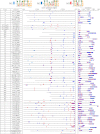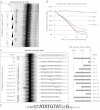Insulator-like pairing elements regulate silencing and mutually exclusive expression in the malaria parasite Plasmodium falciparum
- PMID: 23197831
- PMCID: PMC3535642
- DOI: 10.1073/pnas.1214572109
Insulator-like pairing elements regulate silencing and mutually exclusive expression in the malaria parasite Plasmodium falciparum
Abstract
Plasmodium falciparum causes the deadliest form of human malaria. Its virulence is attributed to its ability to modify the infected RBC and to evade human immune attack through antigenic variation. Antigenic variation is achieved through tight regulation of antigenic switches between variable surface antigens named "P. falciparum erythrocyte membrane protein-1" encoded by the var multicopy gene family. Individual parasites express only a single var gene at a time, maintaining the remaining var genes in a transcriptionally silent state. Strict pairing between var gene promoters and a second promoter within an intron found in each var gene is required for silencing and counting of var genes by the mechanism that controls mutually exclusive expression. We have identified and characterized insulator-like DNA elements that are required for pairing var promoters and introns and thus are essential for regulating silencing and mutually exclusive expression. These elements, found in the regulatory regions of each var gene, are bound by distinct nuclear protein complexes. Any alteration in the specific, paired structure of these elements by either deletion or insertion of additional elements results in an unregulated var gene. We propose a model by which silencing and mutually exclusive expression of var genes is regulated by the precise arrangement of insulator-like DNA pairing elements.
Conflict of interest statement
The authors declare no conflict of interest.
Figures





Similar articles
-
Strict pairing of var promoters and introns is required for var gene silencing in the malaria parasite Plasmodium falciparum.J Biol Chem. 2006 Apr 14;281(15):9942-52. doi: 10.1074/jbc.M513067200. Epub 2006 Feb 2. J Biol Chem. 2006. PMID: 16455655 Free PMC article.
-
Active transcription is required for maintenance of epigenetic memory in the malaria parasite Plasmodium falciparum.J Mol Biol. 2008 Oct 3;382(2):288-97. doi: 10.1016/j.jmb.2008.07.015. Epub 2008 Jul 16. J Mol Biol. 2008. PMID: 18656490 Free PMC article.
-
Dual regulatory effects of non-coding GC-rich elements on the expression of virulence genes in malaria parasites.Infect Genet Evol. 2015 Dec;36:490-499. doi: 10.1016/j.meegid.2015.08.023. Epub 2015 Aug 20. Infect Genet Evol. 2015. PMID: 26299885
-
Mutually exclusive var gene expression in the malaria parasite: multiple layers of regulation.Trends Parasitol. 2008 Oct;24(10):455-61. doi: 10.1016/j.pt.2008.07.005. Epub 2008 Sep 2. Trends Parasitol. 2008. PMID: 18771955 Review.
-
Activation, silencing and mutually exclusive expression within the var gene family of Plasmodium falciparum.Int J Parasitol. 2006 Aug;36(9):975-85. doi: 10.1016/j.ijpara.2006.05.007. Epub 2006 Jun 9. Int J Parasitol. 2006. PMID: 16797552 Review.
Cited by
-
An upstream open reading frame (uORF) signals for cellular localization of the virulence factor implicated in pregnancy associated malaria.Nucleic Acids Res. 2018 Jun 1;46(10):4919-4932. doi: 10.1093/nar/gky178. Nucleic Acids Res. 2018. PMID: 29554358 Free PMC article.
-
Genome-wide profiling of chromosome interactions in Plasmodium falciparum characterizes nuclear architecture and reconfigurations associated with antigenic variation.Mol Microbiol. 2013 Nov;90(3):519-37. doi: 10.1111/mmi.12381. Epub 2013 Sep 30. Mol Microbiol. 2013. PMID: 23980881 Free PMC article.
-
Recent advances in malaria genomics and epigenomics.Genome Med. 2016 Sep 7;8(1):92. doi: 10.1186/s13073-016-0343-7. Genome Med. 2016. PMID: 27605022 Free PMC article. Review.
-
Malaria Epigenetics.Cold Spring Harb Perspect Med. 2017 Jul 5;7(7):a025528. doi: 10.1101/cshperspect.a025528. Cold Spring Harb Perspect Med. 2017. PMID: 28320828 Free PMC article. Review.
-
Shared Mechanisms for Mutually Exclusive Expression and Antigenic Variation by Protozoan Parasites.Front Cell Dev Biol. 2022 Mar 8;10:852239. doi: 10.3389/fcell.2022.852239. eCollection 2022. Front Cell Dev Biol. 2022. PMID: 35350381 Free PMC article. Review.
References
-
- WHO 2010. World Malaria Report 2010. (World Health Organization, Geneva)
-
- Chen Q, et al. Developmental selection of var gene expression in Plasmodium falciparum. Nature. 1998;394(6691):392–395. - PubMed
Publication types
MeSH terms
Substances
LinkOut - more resources
Full Text Sources
Research Materials

